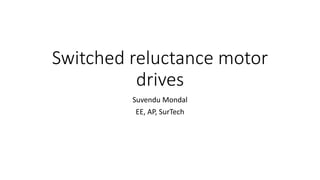
Switched reluctance motor drives.pptx
- 1. Switched reluctance motor drives Suvendu Mondal EE, AP, SurTech
- 2. Evolution of switched reluctance motors • Switched Reluctance Motors (SRMs) have been around for over a century, but their popularity has increased in recent years due to their advantages in terms of cost, simplicity, and reliability. Here is a brief evolution of SRMs: • - Early developments: The earliest SRMs were developed in the late 1800s and early 1900s. These motors used fixed stator windings and a rotating magnetic rotor. They were used primarily in low-power applications, such as toys and small appliances. • - Advancements in control: In the 1960s and 1970s, advancements in control theory and power electronics led to the development of more sophisticated SRM control systems. These systems allowed for more precise control of the motor torque and speed. • - Industrial applications: In the 1980s and 1990s, SRMs began to be used in industrial applications, particularly in high-torque and high-speed applications. The development of more efficient and powerful magnetic materials, such as neodymium magnets, helped to increase the power density and performance of SRMs. • - Improved rotor design: In the 2000s, advancements in rotor design led to the development of improved SRM geometries, such as the doubly salient and flux-switching SRMs. These designs allowed for higher torque and power output, as well as better efficiency. • - Hybridization with other motor types: In recent years, SRMs have been hybridized with other motor types, such as Permanent Magnet Synchronous Motors (PMSMs), to create hybrid SRM-PMSM motors. These motors combine the simplicity and reliability of SRMs with the high efficiency and power density of PMSMs. • Overall, the evolution of SRMs has been characterized by advancements in control, materials, and rotor design. These advancements have helped to increase the power density, efficiency, and performance of SRMs, making them a popular choice for a wide range of applications.
- 3. Various topologies for SRM drives • There are several topologies for Switched Reluctance Motor (SRM) drives, each with its own advantages and disadvantages. Here are some of the most common topologies: • 1. Four-switch drive: This is the simplest and most common SRM drive topology. It uses four power switches, two for the stator winding and two for the rotor winding. This topology is relatively easy to control and has low component count, but it may have limitations in terms of speed and torque control. • 2. Six-switch drive: This topology adds two more power switches to the four-switch drive, allowing for more precise control of the motor speed and torque. The extra switches allow for better current control and faster switching speeds, which can improve the performance of the motor. However, this topology is more complex and expensive than the four-switch drive. • 3. Matrix converter drive: This topology replaces the traditional rectifier-inverter stage with a matrix converter, which can directly convert AC to AC. This eliminates the need for bulky DC link capacitors and reduces the overall size and weight of the drive. However, matrix converters can be complex to control and may have limitations in terms of power output. • 4. Dual-bridge converter drive: This topology uses two separate bridges, one for the stator winding and one for the rotor winding. This allows for independent control of the two windings and can improve the efficiency and performance of the motor. However, this topology is more complex and may be more expensive than other topologies. • 5. Resonant converter drive: This topology uses resonant circuits to reduce the switching losses and improve the efficiency of the motor. The resonant circuits can also reduce the electromagnetic interference (EMI) generated by the motor. However, resonant converters can be difficult to design and control. • Overall, the choice of SRM drive topology depends on the specific requirements of the application, such as power output, control complexity, and cost. Each topology has its own advantages and limitations, and the selection of the right topology requires careful consideration of these factors.
- 4. Closed loop speed and torque control of SRM • Closed loop speed and torque control of Switched Reluctance Motors (SRMs) typically involves using a feedback control system to adjust the power input to the motor based on its current speed and torque output. Here are some common approaches for closed loop speed and torque control of SRMs: • 1. Current mode control: This approach uses a current feedback loop to regulate the motor current and torque output. The motor current is measured using current sensors, and the feedback control system adjusts the power input to maintain a desired current level. This approach is simple and effective, but it may have limitations in terms of speed control and dynamic performance. • 2. Voltage mode control: This approach uses a voltage feedback loop to regulate the motor speed and torque output. The motor speed is measured using speed sensors, and the feedback control system adjusts the voltage input to maintain a desired speed level. This approach is more complex than current mode control, but it can provide better speed control and dynamic performance. • 3. Hybrid control: This approach combines current mode control and voltage mode control to achieve both good torque control and speed control. The feedback control system uses both current and voltage feedback loops to regulate the motor current and speed simultaneously. • 4. Model-based control: This approach uses a mathematical model of the motor and feedback control system to predict the motor behavior and adjust the power input accordingly. This approach can provide high accuracy and performance, but it requires a detailed understanding of the motor characteristics and a complex control algorithm. • Overall, closed loop speed and torque control of SRMs can help to improve the motor performance and efficiency, as well as extend the motor's lifetime. The choice of control approach depends on the specific requirements of the application, such as speed and torque accuracy, control complexity, and cost.